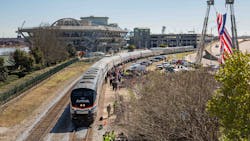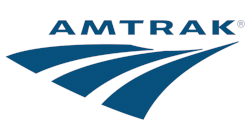Amtrak files for expedited consideration of Gulf Coast service restoration with STB
Amtrak is asking the Surface Transportation Board (STB) to expedite a decision on its request to operate trains between New Orleans and Mobile starting in 2022. The formal request is designed to restore passenger rail service along a route that was suspended in 2005 following Hurricane Katrina and after more than five years “of data-driven and federally led studies.”
STB could require Class 1 freight railroads CSX Transportation and Norfolk Southern Railway to permit twice daily roundtrip trains unless the freight railroads can prove why passenger trains cannot be hosted successfully.
Amtrak has statutory rights to run the trains on the route, which the passenger railroad says has sufficient capacity to host both freight and passenger traffic and the three railroads have successfully worked to share track in other areas of the U.S.
CSX Transportation and Norfolk Southern Railway own the infrastructure future Gulf Coast Amtrak trains would operate over and CSX rebuilt the infrastructure after Hurricane Katrina washed a large portion of it away. CSX has expressed concern in the past that adding passenger trains could negatively impact its ability to move freight from the Port of Alabama. In 2017, CSX, citing the line’s high number of drawbridges and other components, estimated an additional $2 billion would be needed to further shore up the infrastructure to ensure safe operation of both freight and passenger trains and meet an 80-percent on-time rate.
The Gulf Coast Working Group, formed in 2015, produced a plan in 2017 identifying, among other elements, the preferred route between New Orleans and Mobile. The Federal Railroad Administration (FRA), which administered the study by the working group, identified a list of priority infrastructure projects to support restoration of passenger rail service. A total of $66 million is available for these projects and represents a combination of state funding commitments from Mississippi and Louisiana, as well as a $33-million FRA grant through the Consolidated Rail Infrastructure and Safety Improvements (CRISI) program awarded to the Southern Rail Commission (SRC) in 2019.
“Amtrak has a right to use these railroads’ tracks but, unfortunately, we have been unable to reach agreement after years of effort just to operate two short and quick round trip Amtrak trains,” said Dennis Newman, Amtrak executive vice president for Planning and Asset Development. “It is time for the STB to step in to protect Amtrak’s rights to use freight railroad tracks to support service across America. The SRC and other state or regional groups look to partner with Amtrak to deliver safe, reliable and relevant service and while we often reach agreements and co-invest with freight railroads without the STB’s involvement, we need the STB to bring this protracted process to a close.”
He added, “We want to deliver this service next year, not some day far away, and the STB is the proper forum for resolution.”
The proposed service restoration
The proposed schedule would see one train depart from Mobile and another from New Orleans in the morning, passing each other in Mississippi, where almost $45 million in improvements are proposed and funded. Amtrak operations at Mobile would be scheduled with approximately 12 hours between the two departures and 10 hours between the two arrivals.
Amtrak trains would serve a downtown Mobile station and park off the CSX mainline at a dedicated storage track, which is more than one mile west of the Alabama State Docks main and interchange tracks. Amtrak notes this station site is within walking distance of businesses, such as restaurants, hotels and other attractions, and directly between the cruise ship terminal and the city’s convention center.
Mobile is also considering a suburban stop that could provide air-rail mobility as commercial aviation is developed at Brookley Field, just as Amtrak does daily between downtown Milwaukee and its airport.
Passenger rail advocates show support
John Robert Smith, chairman of Transportation for America and former mayor of Meridian, Miss., recognized the importance of freight railroads to the nation’s logistics network but said they can also “serve as a hurdle to delivering passenger rail that meets 21st century needs,” leaving Amtrak no other solution than to file with the STB.
“Slow STB decisions—due to limited capacity—benefit those standing in the way of passenger rail in the long-term, and end up discouraging many areas from even considering passenger rail as a solution to mobility needs. We are happy to see the STB take steps to address this problem and hope to see more and more reliable passenger rail as a result,” said Smith.
SRC noted in its statement that FRA, at the direction of Congress, evaluated what was needed to restore service to the Gulf Coast. SRC worked with FRA on the 2017 report outlining where investments were needed to deliver safe, reliable service.
“We have that funding now secured and we are ready to move forward,” said Knox Ross, Mississippi SRC commissioner. “Our local communities are frustrated by all the years of studying and waiting and we are hoping this public and transparent process will resolve all outstanding issues so that service can begin soon.”
Sen. Roger Wicker (R-Miss.), who has been a longtime supporter of the effort to restore Amtrak service, explained seeing the trains roll again would symbolize the strides made by Mississippi “to recover from one of the most devastating storms on record.”
“Reconnecting the Gulf Coast to our nation’s passenger rail network will increase access to jobs, boost tourism, provide a safe alternative to highway travel and improve quality of life across the region. Our goal is to have successful freight and passenger rail service on the Gulf Coast, and I look forward to the Surface Transportation Board considering this matter,” said Sen. Wicker.
Perhaps the most ardent statement of support came from the Rail Passengers Association President and CEO Jim Mathews who posted a blog in response to Amtrak’s petition with the STB calling it the “next logical step” in a process Mathews says was slowed by the freight railroads’ “obstructionism.” Mathews wrote delaying passenger rail restoration would deny Alabama key economic benefits associated with construction activities surrounding the launch of service, as well as annual economic benefits of continued rail service.
In a prepared statement from the association, Mathews said, “The overriding principle at play is Amtrak’s legal right to access freight railroad track structure for a fair and reasonable cost. CSX has said it will take $2 billion to accommodate a single train every 12 hours; that is not reasonable and it is not fair.”
He continued, “Amtrak’s decision to go to the STB will allow us to see what the true costs of restoring this service will be.”

Mischa Wanek-Libman | Group Editorial Director
Mischa Wanek-Libman is director of communications with Transdev North America. She has more than 20 years of experience working in the transportation industry covering construction projects, engineering challenges, transit and rail operations and best practices.
Wanek-Libman has held top editorial positions at freight rail and public transportation business-to-business publications including as editor-in-chief and editorial director of Mass Transit from 2018-2024. She has been recognized for editorial excellence through her individual work, as well as for collaborative content.
She is an active member of the American Public Transportation Association's Marketing and Communications Committee and served 14 years as a Board Observer on the National Railroad Construction and Maintenance Association (NRC) Board of Directors.
She is a graduate of Drake University in Des Moines, Iowa, where she earned a Bachelor of Arts degree in Journalism and Mass Communication.




